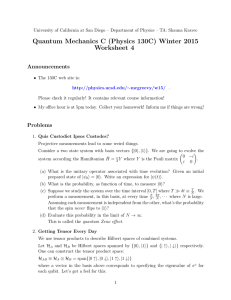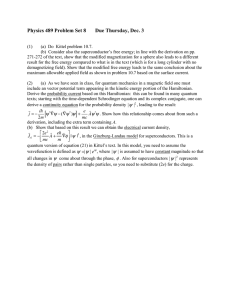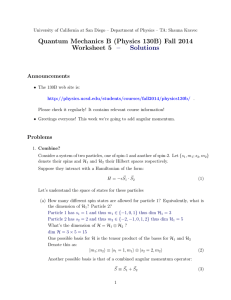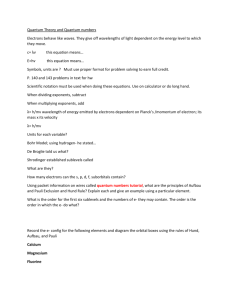Quantum Mechanics C (Physics 130C) Winter 2014 Worksheet 4
advertisement
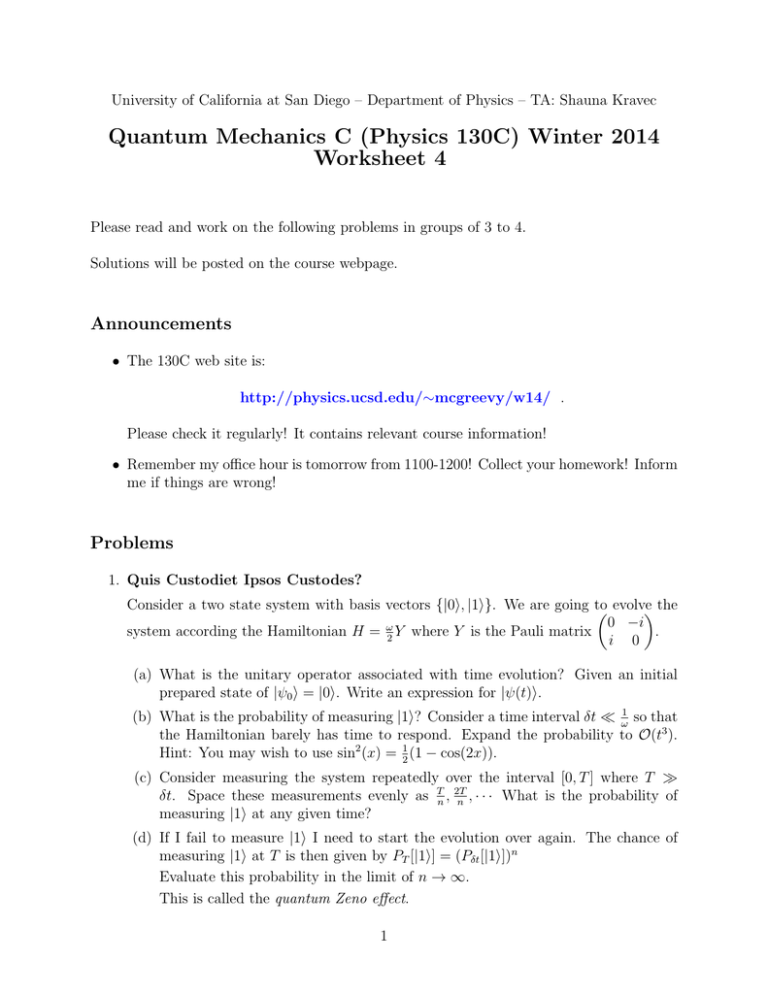
University of California at San Diego – Department of Physics – TA: Shauna Kravec
Quantum Mechanics C (Physics 130C) Winter 2014
Worksheet 4
Please read and work on the following problems in groups of 3 to 4.
Solutions will be posted on the course webpage.
Announcements
• The 130C web site is:
http://physics.ucsd.edu/∼mcgreevy/w14/ .
Please check it regularly! It contains relevant course information!
• Remember my office hour is tomorrow from 1100-1200! Collect your homework! Inform
me if things are wrong!
Problems
1. Quis Custodiet Ipsos Custodes?
Consider a two state system with basis vectors {|0i, |1i}. We are going to
evolve
the
0 −i
system according the Hamiltonian H = ω2 Y where Y is the Pauli matrix
.
i 0
(a) What is the unitary operator associated with time evolution? Given an initial
prepared state of |ψ0 i = |0i. Write an expression for |ψ(t)i.
(b) What is the probability of measuring |1i? Consider a time interval δt ω1 so that
the Hamiltonian barely has time to respond. Expand the probability to O(t3 ).
Hint: You may wish to use sin2 (x) = 12 (1 − cos(2x)).
(c) Consider measuring the system repeatedly over the interval [0, T ] where T δt. Space these measurements evenly as Tn , 2T
, · · · What is the probability of
n
measuring |1i at any given time?
(d) If I fail to measure |1i I need to start the evolution over again. The chance of
measuring |1i at T is then given by PT [|1i] = (Pδt [|1i])n
Evaluate this probability in the limit of n → ∞.
This is called the quantum Zeno effect.
1
(e) Let me contextulaize the result above. We’ve made some sketchy arguments
above in: our ability to measure arbitrarily quickly, and the assumption of nocorrelations between measurements.
One can consider a more careful analysis where measurement is done by coupling
the system to a device and one finds random ’jumps’ to the state |1i.
This is an important problem in the field of continuous quantum measurement.
2. C-NOT Evil
In quantum mechanics we use tensor products to describe Hilbert spaces of combined
systems.
Let HA and HB be Hilbert spaces spanned by {|0A i, |1A i} and {|0B i, |1B i} respectively.
Let us construct the following operator on their tensor product space HAB :
UAB ≡ |0A ih0A | ⊗ 1 B + |1A ih1A | ⊗ XB
Where XB can be written as XB = |0B ih1B | + |1B ih0B |. It’s a Pauli X acting on HB .
Write a matrix representation of UAB in the following basis for HAB :
{|0A i ⊗ |0B i, |0A i ⊗ |1B i, |1A i ⊗ |0B i, |1A i ⊗ |1B i} ≡ {|0A 0B i, |0A 1B i, |1A 0B i, |1A 1B i}
What are the eigenstates of this operator? In which of these states are A and B
entangled?1
1
Can you write them as a product of states from HA and HB independently?
2
